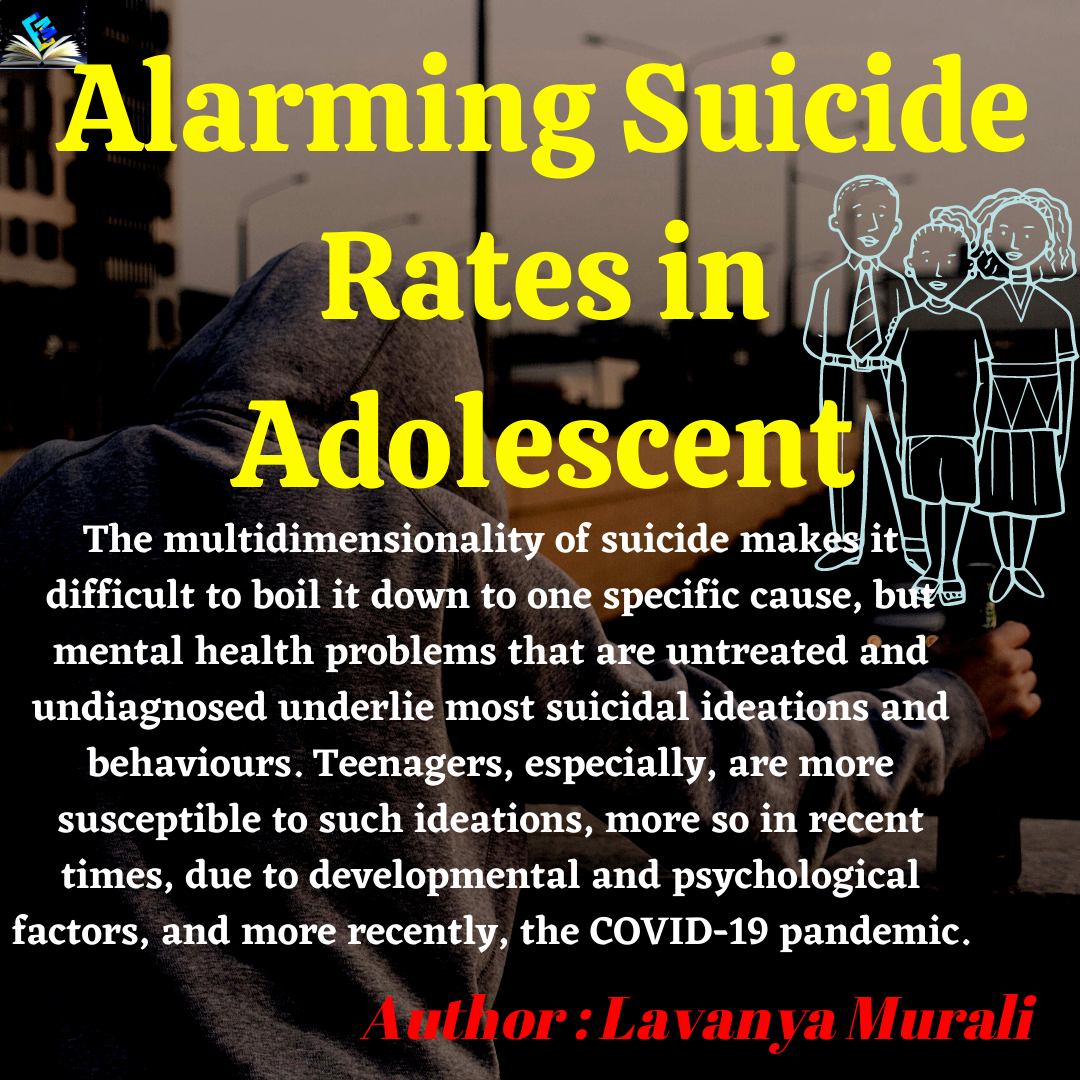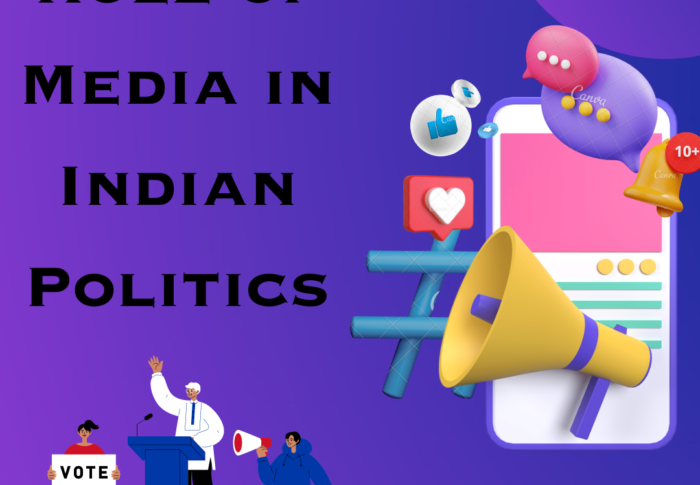
Alarming Suicide Rates in Adolescent
Why are the rates of suicide in adolescents increasing, and how can this problem be dealt with?
Author : Lavanya Murali
Keyword- Suicide and Adolescent
Abstract
Suicide is often the successor of several health problems, but more commonly, depression. With the increase in the rate of mental health problems as a result of various causes, including but not limited to, socioeconomic, educational, financial factors, bullying and cyberbullying, familial factors and quite markedly in recent times, the pandemic. Suicide in adolescents is more common in developing and third-world countries and India is no stranger to this. The National Crime Records Bureau has reported that every hour, one student commits suicide in India.
Introduction
Suicide is a fatal, self-inflicted act with specific intent to die. Suicides are recognized as a public health priority by the World Health Organization (WHO). According to the WHO, it is the third leading cause of adolescent deaths across the globe and in recent times the rates of suicide are increasing rapidly. The WHO is working towards increasing awareness regarding this and make suicide prevention a global health priority. The CDC reported that the suicide rate in American teenagers increased by 31% from 2010 to 2015. These staggering statistics are also a reflection of the difficulties in achieving the third Sustainable Development Goal (SDG3), which is to ensure healthy lives and promote wellbeing for all. In India, the highest rates of suicide are among those below the age of 30.
Suicide is often the successor of several health problems, but more commonly, depression. With the increase in the rate of mental health problems as a result of various causes, including but not limited to, socioeconomic, educational, financial factors, bullying and cyberbullying, familial factors and quite markedly in recent times, the pandemic. Suicide in adolescents is more common in developing and third-world countries and India is no stranger to this. The National Crime Records Bureau has reported that every hour, one student commits suicide in India. The well-being of adolescents is deteriorating expeditiously and this must be addressed and responded to promptly. In this article, the causes for these unfortunate demises and ways to prevent them will be discussed in detail.
Causes of Increasing Rates of Suicide among Teenagers
The risk factors for suicide are multifold, and can easily be misunderstood and left untreated.
Development in Adolescence
Adolescence is a period of marked developmental change. There are tremendous changes in the social, biological and cognitive aspects of life. Research conducted by Robing D Everall in 2005 has explored the developmental themes in a suicidal adolescent. In this research, the author has suggested that the development of cognition, the formation of identity and the hunt for autonomy might have an important impact on suicidality in adolescents. Increasing our understanding of these developmental aspects may supplement our cognizance of suicide in adolescents. The author is of the view that adolescents increasingly focus on the changes in themselves and become egocentric and self-conscious. They are also susceptible to selective abstraction, which is to dwell on negative outcomes and experiences and disregard positive ones, and this could contribute towards suicidal ideation and behaviour.
The most important theory he draws from is Erikson’s psychosocial development. The concept of identity versus identity confusion and the distress associated with the inability to understand or define oneself and create an identity in this world is said to have an adverse impact on mental health, often leading to depression and regression, and as a result, can manifest as suicidal ideation or attempts. In line with this, Meeus et. all have concluded that a state of identity exploration with low levels of commitment was associated with low psychological well-being. Stillon and McDowell have suggested an association between maladaptive coping and a risk factor for suicidality in adolescents. In another research, it was found that adolescents with suicidal ideations scored significantly lower on ego identity factors in comparison to their non-suicidal counterparts.
Psychological Factors
Mental health issues, when undiagnosed and untreated, can often lead to unfortunate outcomes, and suicide is one of them. Suicidal ideation and behaviour are invariably linked to a mental health issue. In a study conducted in Belgium in 2005, it was found that adolescents who had committed suicide were suffering from one or more mental health issues when they passed away. Adolescents suffering from depression, anxiety, personality disorders, substance abuse issues, eating disorders and any other mental health problems are susceptible to suicidal ideations. Epidemiological studies suggest that at any point in time 8-10% of adolescents suffer from severe depression. According to the APA, the rate of adolescents reporting symptoms consistent with depression increased 52% from 2005 to 2009 in America. According to WHO, 10-20% of adolescents globally experience mental health conditions, but most of them are undiagnosed and untreated.
Body Image Issues
A study conducted by researchers at Bradley Hospital, Butler Hospital and Brown Medical School has found that adolescents are rife with body image issues, and adolescents with negative body images are more likely to be depressed, anxious and suicidal. The increased use of social media has contributed to this damaged, distorted self-image and native body image. Social media is the most influential platform, and the usage of social media has increased significantly over the last few years. The kind of content posted on these sites can often be misleading, can promote beauty standards and can even be discriminatory. As a result, when adolescents engage with such content, they may feel upset or even shame if they are unable to procure items that are trending, or if they do not have the body or clothes that fit into the beauty standards. This can cause body dysmorphia, eating disorders, anxiety and depression.
Excessive Screen Time
Another study found a correlation between screen time, depressive symptoms and suicide-related outcomes. They found that adolescents who reported to have spent over five hours per day on electronic devices expressed at least one suicide-related outcome, and this consisted of 48% of the sample. Depressive symptoms were also more common among teenagers who spent more time on their electronic devices. These findings are supported by the study conducted by Twenge et al., who found that the rise in mental health problems among teenagers since 2010 coincides with the increase in the ownership of cell phones. Twenge stressed the fact that there is no way to prove if screen time does cause depression or suicidal symptoms, but the findings do reveal a correlation. This coincides with the finding that greater use of social media does lead to symptoms of depression and anxiety since the increased use of gadgets has led to an increase in screen time.
The increased use of gadgets has also led to more cyberbullying. It has been found that children and adults under 25 who experience cyberbullying are more likely to engage in self-harm and suicidal behaviour than those who don’t. Excessive use of social media and gadgets also hinders cognitive growth since they replace the interpersonal relationships that are vital for one’s development.
Familial Environment
The family unit is integral in providing a safe environment for adolescents, and when this is not present, this can lead to great distress and anxiety. Along with the number of issues that they face, in development and society, if adolescents are unable to receive adequate support in their house, it can be a factor that greatly contributes to suicidal ideation or enaction. When adolescents are securely attached to their caregivers, it allows them to rely on authority figures while exploring their identities. Teens whose parents were insensitive and unavailable are more prone to depression, decreased self-esteem and aggression. In the Indian culture especially, the family unit has both a positive and negative impact on suicide. Mental health issues are taboo in India, and people perceive having them as shameful. Considering the significant role played by religion in India, the family often seeks herbal remedies and help from religious leaders. Mental health issues are hence often left undiagnosed and untreated as a result of the Indian conservative view on psychological issues.
Pandemic Stressors
Most notably, in the last two years, the spread of the pandemic has greatly contributed to the decline in the mental health of adolescents. People have had to remain inside abusive households for extended periods, live with unsupportive parents and many adolescents have even lost one or both parents. The uncertainty about school and college, the inability to socialise effectively and the anxiety about the Coronavirus itself, adjustment to the new normal of social distancing and isolation and excessive screen time along with a barrage of other things that require acclimatization has caused adolescents to feel distressed. In recent years, therefore, the mental health of adolescents has deteriorated rapidly, and this is an important factor in the rising rates of suicide in teenagers.
Methods to Help Adolescents with Suicidal Ideation
Despite the extensive research on the topic, it is difficult to pinpoint any one factor as the cause of suicide, for it is the result of an amalgamation of reasons. However, one thing can be concluded. If a mental disorder is unrecognized and untreated, it can result in suicide. Risk factors and protective factors can occur at many levels, including biological, physical, mental, cultural, social and spiritual. Destigmatization of mental illness and therapy is the most fundamental step in reducing suicidal and self-harming behavior in adolescents. Psychoeducational, therefore, is the best bet in helping people who are at risk. Psychoeducational must be accurate and sensitive and must be dealt with at the family and school levels. Teachers should be trained to notice warning signs of mental health issues, and educated on how to handle them as non-mental health professionals. Psychoeducation of children must be included in the pedagogy of all schools. When children at the school level are sensitised to the issues, the next generation can receive support from their parents and family. Support from parents and family is crucial in aiding people with suicidal ideations.
In a study done by researchers at the University of Vermont. It was found that being physically active for four or more days per week resulted in a 23% reduction in suicidal ideation and behavior in bullied students. Therefore, all schools should encourage more active time and P.E classes. Physical exercise must also be encouraged in all children.
People should be educated on the proper use of technology, and strict measures should be taken to punish those who engage in activities like cyberbullying. Such policies should be included in school policies. Even therapists should be trained to routinely ask about experiences of cyberbullying. The use of social media for productive purposes must be promoted.
A preliminary study from UT Southwestern’s O’Donnell Brain Institute shows an intervention program that includes a personalized app. This has provided astonishing results. The rate of attempted suicides by teenagers was almost halved compared to those who received standard treatment. The intervention program is a brief three-hour session where the therapists offer various coping strategies and learn about the patient’s fond memories and favourite activities. This information is then injected into the app called BRTIE and the teen can use this after being discharged. Every day, they are prompted by the app to rate their moods and they are offered personalised recovery plans by it during times of distress. This could offer groundbreaking progress in the attempts to reduce suicidal behaviour and intention in adolescents.
Conclusion
Suicide, then, is a result of the coalescence of several factors spanning the social, cognitive, behavioural, psychological and economic aspects of an individual’s life. The multidimensionality of suicide makes it difficult to boil it down to one specific cause, but mental health problems that are untreated and undiagnosed underlie most suicidal ideations and behaviours. Teenagers, especially, are more susceptible to such ideations, more so in recent times, due to developmental and psychological factors, and more recently, the COVID-19 pandemic. To reduce the incidence of such behavior, it is important to destigmatize mental health and therapy, psych educate parents, teachers and children, and place strict laws on activities that deprive people of the right to good mental health.
Mail at info@edumound.com






